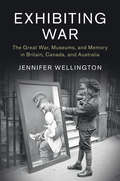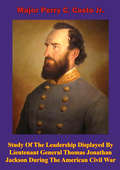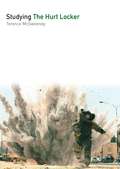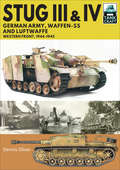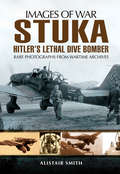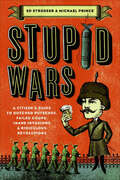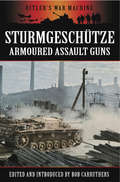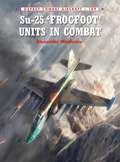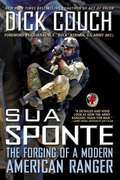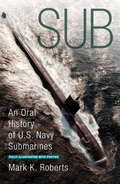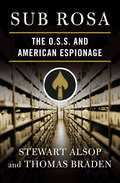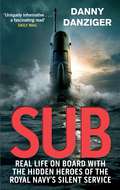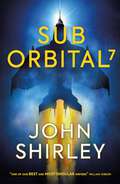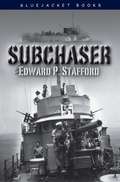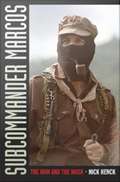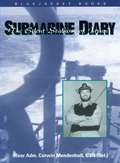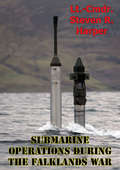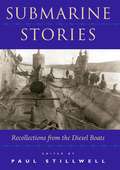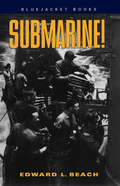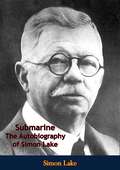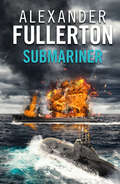- Table View
- List View
Studies in the Social and Cultural History of Modern Warfare: The Great War, Museums, and Memory in Britain, Canada, and Australia (Studies in the Social and Cultural History of Modern Warfare #53)
by Jennifer WellingtonWhat does it mean to display war? Examining a range of different exhibitions in Britain, Canada and Australia, Jennifer Wellington reveals complex imperial dynamics in the ways these countries developed diverging understandings of the First World War, despite their cultural, political and institutional similarities. While in Britain a popular narrative developed of the conflict as a tragic rupture with the past, Australia and Canada came to see it as engendering national birth through violence. Narratives of the war's meaning were deliberately constructed by individuals and groups pursuing specific agendas: to win the war and immortalise it at the same time. Drawing on a range of documentary and visual material, this book analyses how narratives of mass violence changed over time. Emphasising the contingent development of national and imperial war museums, it illuminates the way they acted as spaces in which official, academic and popular representations of this violent past intersect.
Study Of The Leadership Displayed By Lieutenant General Thomas Jonathan Jackson During The American Civil War
by Major Perry C. Casto Jr.Confederate Lieutenant General Thomas J. Jackson is considered one of the greatest tacticians who ever lived. His Valley Campaign of 1862 is a classic example of the effective use of maneuver warfare. While much has been written about Jackson's tactics, very little attention has been paid to his leadership of the soldiers who executed his tactical plans. The United States Army's recent emphasis on maneuver warfare has stressed the importance of leadership in the conduct of such warfare. This study is an analysis of Jackson's military leadership as he commanded units from brigade to corps level in the Confederate Army of Northern Virginia to determine if he met the requirements of a good leader as those requirements are defined by current US Army doctrine. The study uses current Army doctrine as the basis to judge the effectiveness of Jackson as a leader. It discusses Jackson's background and its effect on the character of his leadership, the leadership that he displayed during the Civil War, and then compares his actions to current doctrine. The study concludes that while some of Jackson's actions deviated significantly from today's doctrinally sound leadership practices, in the aggregate his leadership was congruous with current doctrine and contributed to his success as a field commander.
Study of Economic History: Collected Inaugural Lectures 1893-1970
by N. B. HartePublished in the year 1975, Study of Economic History is a valuable contribution to the field of Military and Strategic Studies.
Studying The Hurt Locker (Studying Films)
by Terence McSweeneyIn this vibrant and dynamic book-length study drawing on a broad tapestry of research, Terence McSweeney offers an exploration of The Hurt Locker (2009), its stylistic and narrative devices, its cultural impact, its reception, and its relationship to the genre of the war film. McSweeney places the film in a richly textured historical, political, and industrial context, arguing that The Hurt Locker is part of a long tradition of films about American wars that play a considerable role in how audiences come to understand the conflicts that they depict. Thus, films about a nation’s wars are never “only a movie” but rather should be considered a cultural battleground themselves on which a war of representation is waged.
Stuffed Saddlebags: The Life of Martin Kundig, Priest 1805-1879
by Peter Leo JohnsonStuffed Saddlebags: The Life of Martin Kundig, Priest 1805-1879 is a biographical book written by Peter Leo Johnson. The book is a detailed account of the life of Martin Kundig, a Swiss Catholic priest who lived from 1805 to 1879. Kundig was a prominent figure in the Catholic Church and played a significant role in the religious and social history of Switzerland. The book provides a comprehensive overview of Kundig's life, from his childhood in Switzerland to his religious training and eventual ordination as a priest. The author delves into Kundig's experiences as a missionary in the United States and his work in establishing Catholic parishes and schools in the American Midwest. The book also explores Kundig's involvement in the political and social issues of his time, including his support for the abolition of slavery and his advocacy for the rights of immigrants. The author provides a detailed analysis of Kundig's writings and sermons, which reflect his commitment to social justice and his belief in the importance of education. Overall, Stuffed Saddlebags is a fascinating and insightful biography of a remarkable individual who played a significant role in the history of the Catholic Church and the United States. The book is well-researched and provides a rich and detailed portrait of Kundig's life, beliefs, and achievements. It is an excellent read for anyone interested in the history of the Catholic Church, American social history, or the life of a remarkable individual.-Print ed.
Stug III & Stug IV: German Army, Waffen-SS and Luftwaffe: Western Front, 1944–1945 (TankCraft)
by Dennis OliverA guide that blends the history behind this German World War II tank with resources for military vehicle modeling enthusiasts. In the last years of the Second World War the Sturmgeschütz III (StuG III) and Sturmgeschütz IV (StuG IV) played a vital role as assault guns during the German army&’s struggle to block the Allied advance on the Western Front. As the Wehrmacht&’s tank forces declined, these armored vehicles were thrown into every defensive operation. They are not as well-known as the Tigers and Panthers, but German resistance would have been much weaker without them. They were also among the most frequently encountered German armored vehicles on the battlefields, which is why they are such a fascinating subject for Dennis Oliver in this volume in the TankCraft series He uses archive photos and extensively researched color illustrations to examine the StuG III and StuG IV deployed by the German army and the Waffen-SS during these doomed campaigns. A key section of his book displays available model kits and aftermarket products, complemented by a gallery of beautifully constructed and painted models in various scales. Technical details as well as modifications introduced during production and in the field are also examined providing everything the modeler needs to recreate an accurate representation of these historic armored vehicles.
Stuka: Hitler's Lethal Dive Bomber (Images of War)
by Alistair Smith&“A very nice release about the most recognizable German aircraft of the Second World War&” from the author of Rommel&’s Army in the Desert (Inscale.org). The photographs in this collection belonged to Luftwaffe Stuka rear gunner and radio operator Erich Heine. The collection includes photographs of flights of Stukas in formation, operating training aircraft, and a selection of different Luftwaffe uniforms and flight gear. The photographer was based for a period in Czechoslovakia, was shot down over the Ukraine in August 1943 and for a time was listed as missing in action. This collection offers a unique insight into the German experience of World War Two, providing the opportunity to access materials that have never been published before&“The book very ably documents the war career of the aircraft and the pilots, reproducing some outstanding images of war.&” —Firetrench&“The most remarkable thing about this album is that it contains photographs of perhaps the most famous Stuka ace, Hans-Ulrich Rudel.&” —Inscale.org&“The photographs . . . show the life of Erich and Luftwaffe Stuka crew members through training/deployment/leave and include funerals of squadron members . . . The narrative gives a good overview of the Stuka in service and the photographs show varied views of the aircraft and day to day life within the squadron.&” —WW2 Talk
Stupid Wars: A Citizen's Guide to Botched Putsches, Failed Coups, Inane Invasions & Ridiculous Revolutions
by Ed Strosser Michael PrinceWhen winners write history, they sometimes "forget" to include their own embarrassing misjudgments. Fortunately, this take-no-prisoners edition of history isn't going to let the winners (or the losers) forget the mistakes of the past. Be prepared to laugh out loud—and gasp in horror—at the most painfully idiotic strategies, alliances, and decisions the world has ever known. These stupid wars have been launched by democracies as well as monarchies and dictatorships, in recent decades just as often as in less "enlightened" times. The ridiculous and reckless conflicts chronicled in Stupid Wars include the misdirected Fourth Crusade, the half-baked invasion of Russia by the U.S., the U.K.'s baffling Falklands War, Hitler's ill-fated Beer Hall Putsch, several incredibly foolish South American conflicts, the Bay of Pigs fiasco, and many more. Whether you're a future dictator, war-mongering politician, royal mistress, or history lover, these blow-by-stupid-blow accounts will teach you the valuable lessons you need to stay off the list, including: Don't declare war on all your neighbors at the same time.Working radios, accurate maps, and weather-appropriate uniforms are big plusses.Large amounts of bird poop and very small islands are probably not worth dying for.Never invade Russia. Seriously. It's a really bad idea.
Sturmgeschütze: Armoured Assault Guns (Hitler's War Machine)
by Bob CarruthersAn overview of the Wehrmacht&’s little-known mobile assault guns designed to provide close infantry support against enemy field defenses in World War II. The Stürmgeschutze rumbling forward into action is one of the iconic images of World War II. As mobile assault guns, the StuGs were essentially designed as infantry support weapons, but they also proved themselves as highly effective tank destroyers. Written by Emmy Award-winning author Bob Carruthers this fascinating study encompasses the design, development and combat history of the StuG II and IV. Drawing on a variety of rare primary sources and photographs this outstanding study explains the role of the StuG in context and examines the combat records of the StuG aces such as Franz von Malachowski, and Knight&’s Cross holder Oberwachtmeister Hugo Primozic of Stug.Abt.667. Indispensable reading for anyone with an interest in armored warfare, this book is part of the Hitler&’s War Machine series, a new military history range compiled and edited by Emmy Award winning-author and historian Bob Carruthers. The series draws on primary sources and contemporary documents to provide a new insight into the true nature of Hitler&’s Wehrmacht.
Su-25 'Frogfoot' Units In Combat
by Alexander Miladenov Rolando UgoliniUncover the technical features and operational performance of the Soviet Su-25 'Frogfoot', which proved itself as a durable and versatile attack aircraft in a variety of theaters in the middle East. Had the Cold War developed into a more serious conflict, the Su-25 would have been the main Soviet combat type facing US aircraft.Today it is widely accepted as the true successor to the types of specialized ground--attack aircraft that emerged during World War II. The book details the service history of the 'Frogfoot' during more than 30 years of combat using first-hand accounts and revealing archive photographs. The Su-25 has often been underrated, but the faithful 'Frogfoot' is now slated to remain in service with most of its current operators across the globe until at least 2020. This study explores the successes of the Su-25 in full, demonstrating its' strengths as a formidably armed, armored and very agile attack aircraft.
Sua Sponte
by Dick CouchSua Sponte Latin for "Of Their Own Accord" The 75th Ranger Regiment's Motto Army Rangers are not born. They are made. The modern 75th Ranger Regiment represents the culmination of 250 years of American soldiering. As a fighting force with our nation's oldest and deepest tradition, the Regiment traces its origins to Richard Rogers's Rangers during the prerevolutionary French and Indian War, through the likes of Francis Marion and John Mosby, to the five active Ranger battalions of the Second World War, and finally, to the four battalions of the current Ranger regiment engaged in modern combat. Granted unprecedented access to the training of this highly restricted component of America's Special Operations Forces in a time of war, retired Navy captain Dick Couch tells the personal story of the young men who begin this difficult and dangerous journey to become Rangers. Many will try, but only a select few will survive to serve in the 75th Ranger Regiment. Sua Sponte follows a group of these aspiring young warriors through the crucible that is Ranger training and their preparation for direct-action missions in Afghanistan against America's enemies, anywhere, any time, and under any conditions. INCLUDES PHOTOGRAPHS
Sub
by Mark RobertsTrue tales of life and death as told by those who fought in the briny depths. From the undersea warfare of World War II through the Cold War stand-offs in the deep to the cutting-edge technology of the modern U.S. Navy, submarines have evolved into the front line of our nation's defense at sea. And the men who sail them have become heroes above and below the waves. These are their stories. Compiled from interviews and recollections from submarine veterans and accompanied by detailed photos and illustrations of both man and machine at work, Sub is a gripping chronicle of undersea warfare as told by those who know firsthand what it means to drop through the hull of a boat, to sink into the dark, freezing waters of the deep-and to have death never more than one torpedo away.
Sub Rosa: The O. S. S. and American Espionage
by Stewart Alsop Thomas BradenA thrilling history of the Office of Strategic Services, America&’s precursor to the CIA, and its secret operations behind enemy lines during World War II. Born in the fires of the Second World War, the Office of Strategic Services, or OSS, was the brainchild of legendary US Maj. Gen. William &“Wild Bill&” Donovan, designed to provide covert aid to resistance fighters in European nations occupied by Germany&’s Nazi aggressors. Paratroopers Stewart Alsop and Thomas Braden—both of whom would become important political columnists in postwar years—became part of Wild Bill&’s able collection of soldiers, spies, and covert operatives. Sub Rosa is an enthralling insider&’s history of the remarkable intelligence operation that gave birth to the CIA. In Sub Rosa, Alsop and Braden take readers on a breathtaking journey through the birth and development of the top secret wartime espionage organization and detail many of the extraordinary OSS missions in France, Germany, Dakar and Casablanca in North Africa, and in the jungles of Burma that helped to hasten the end of the Japanese Empire and the fall of Adolf Hitler&’s powerful Reich. As exciting as any international thriller written by Eric Ambler or Graham Greene, Alsop and Braden&’s Sub Rosa is an indispensable addition to the literary history of American espionage and intelligence.
Sub: Real Life on Board with the Hidden Heroes of the Royal Navy's Silent Service
by Danny Danziger300 million cubic miles of ocean.Stealthy, and deadly, the nuclear submarines of the Royal Navy lie in wait in the depths of the world's oceans, ready to listen, intercept, and attack wherever they may be needed - from the coastline of Libya to the ice caps of the Arctic. If the UK is hit by a devastating nuclear strike, they'll be the last military force standing.200 million pounds of hardware.Award-winning journalist Danny Danziger has been allowed unprecedented access to the elite crew of one of the UK's attack class submarines, joining them on operations and hearing their stories. Unrestricted, and uncompromising, Sub paints a vivid picture of this fascinating, little-known branch of our armed forces.One incredible hunter-killer.In an increasingly unstable world, these are the people who keep us safe. It is time for the silent service to be heard.
Sub: Real Life on Board with the Hidden Heroes of the Royal Navy's Silent Service
by Danny Danziger300 million cubic miles of ocean.Stealthy, and deadly, the nuclear submarines of the Royal Navy lie in wait in the depths of the world's oceans, ready to listen, intercept, and attack wherever they may be needed - from the coastline of Libya to the ice caps of the Arctic. If the UK is hit by a devastating nuclear strike, they'll be the last military force standing.200 million pounds of hardware.Award-winning journalist Danny Danziger has been allowed unprecedented access to the elite crew of one of the UK's attack class submarines, joining them on operations and hearing their stories. Unrestricted, and uncompromising, Sub paints a vivid picture of this fascinating, little-known branch of our armed forces.One incredible hunter-killer.In an increasingly unstable world, these are the people who keep us safe. It is time for the silent service to be heard.
SubOrbital 7
by John ShirleyA routine rescue mission leaves a team of US soldiers, rescued hostages and a prisoner trapped above Earth in a suborbital craft, in this cinematic action-packed near-future thriller, perfect for fans of Tom Clancy and Jack Carr.Lieutenant Art Burkett is called up to take part in a rescue mission. Three scientists have been kidnapped by the terrorist group Thieves in Law. The rescue is swift. Art and his team return to military craft SubOrbital 7, intending to return to safety with hostages rescued and prisoners in tow. But Thieves in Law are not the only people looking for them. Art and his team must fight an ever-growing threat before time runs out for them, and possibly for the rest of the world.
Subchaser
by Edward P. StaffordIn a wartime Navy of giant carriers and battleships, tiny wooden subchasers did not command much attention. Yet these 110-foot warships, manned mostly by inexperienced reservists, performed vital chores for the fleet everywhere there was action in World War II. They led landing craft right up to the assault beaches, protected them from fire, fought off air attacks, swept for mines, laid down smoke screens, and patrolled the sea for killer submarines. One such doughty little ship, subchaser 692, is the subject of this book.Told by 692's commanding officer Ed Stafford, then a twenty-four-year-old lieutenant (jg) on his first warship, the story follows the thirty-man crew as they scrapped their way through the war, including action during the July 1943 invasion of Sicily. Filled with humor, tension, poignancy, and moments of high drama, this volume leaves today's readers with a vivid image of life on a very small ship in a very big war.
Subcommander Marcos: The Man and the Mask
by Nick HenckSubcommander Marcos made his debut on the world stage on January 1, 1994, the day the North American Free Trade Agreement took effect. At dawn, from a town-hall balcony he announced that the Zapatista Army of National Liberation had seized several towns in the Mexican state of Chiapas in rebellion against the government; by sunset Marcos was on his way to becoming the most famous guerrilla leader since Che Guevara. Subsequently, through a succession of interviews, communiqus, and public spectacles, the Subcommander emerged as a charismatic spokesperson for the indigenous Zapatista uprising and a rallying figure in the international anti-globalization movement. In this, the first English-language biography of Subcommander Marcos, Nick Henck describes the thought, leadership, and personality of this charismatic rebel spokesperson. He traces Marcos's development from his provincial middle-class upbringing, through his academic career and immersion in the clandestine world of armed guerrillas, to his emergence as the iconic Subcommander. Henck reflects on what motivated an urbane university professor to reject a life of comfort in Mexico City in favor of one of hardship as a guerrilla in the mountainous jungles of Chiapas, and he examines how Marcos became a conduit through which impoverished indigenous Mexicans could communicate with the world. Henck fully explores both the rebel leader's renowned media savvy and his equally important flexibility of mind. He shows how Marcos's speeches and extensive writings demonstrate not only the Subcommander's erudition but also his rejection of Marxist dogmatism. Finally, Henck contextualizes Marcos, locating him firmly within the Latin American guerrilla tradition.
Submarine
by Edward L. Beach"Welcomed as the first book about American submarines in World War II to be written by a man who actually fought in them, this account of the war beneath the sea firmly established Edward L. Beach's reputation as a writer in the early 1950s. Given the survival rate of those in the silent service, it is a story many submariners did not live to tell. In fact, most of the crew of Beach's boat, the USS Trigger, were lost soon after he left for another assignment. A veteran of twelve war patrols, Beach authentically recaptures the moments of elation, desperation, and numbing fear that were part of the daily lives of these warriors as they hunted down the enemy in the Pacific." "Beach helped sink the Trigger's first ships and survived more than his share of exploding depth charges from avenging warships. This book weaves the Trigger's story with the equally thrilling tales of other battle-hardened submarines and the brave men who fought in them against the Japanese. Readers share in the destruction of five destroyers in four days and join in the deadliest game of all - stalking other submarines. They also come to understand the terror and uncertainty of being at the other end of the pursuit, and silently sweating out depth-charge poundings in a leaking boat. For an authentic account of what went on under the waves, this book remains one of the very best."--BOOK JACKET. Title Summary field provided by Blackwell North America, Inc. All Rights Reserved
Submarine Diary
by Corwin MendenhallA vividly detailed account of life aboard U.S. submarines in the Pacific during World War II.
Submarine Operations During The Falklands War
by Lieutenant Commander Steven R. HarperThis paper contains an analysis of submarine operations during the Falklands War. This was done to provide some insight on the importance of submarines in this conflict and to show the usefulness of submarines in any maritime conflict The submarine operations by both belligerents are looked at and compared over the duration of the conflict This is an unclassified study that was researched using published books, magazine articles, unpublished papers, unclassified government documents and interviews with officers involved in the conflict Reports done at a classified level were not used in the preparation of this paper. The submarine operations and methods of employment examined show the strength of submarines when properly used and the weakness when training is lacking or the submarine is used in the wrong manner. Also highlighted is the difficulty of antisubmarine efforts in a high ambient noise, shallow water environment Submarines can be a force multiplier to any navy when used properly and can frustrate an opponent by their presence or even their perceived presence. However, to get the full use of submarines they must be integrated fully into the military forces. With just a few boats in a navy, the submarines are wasted if they are operated independently. They must be fed intelligence or be intelligence platforms themselves to fully realize their potential. This point was not adhered to fully and thus submarines did not make the impact expected during the Falklands War.
Submarine Stories
by Paul L. StillwellCulled from many never-before-published narratives and oral histories conducted under the auspices of the U.S. Naval Institute, Submarine Stories presents nearly five dozen first-person accounts from men who were involved with gasoline- and diesel-powered submarines during the twentieth and twenty-first centuries. The story of these boats, their technological evolution and tactical value, is also the story of the men who went to sea in them. The accounts illustrate the human aspects of serving in diesel boats: the training, operations in peacetime and war, liberty exploits, humorous sidelights, and special feelings of bonding and camaraderie that grew among shipmates.Included here are some familiar names. Slade Cutter, who earned four Navy Crosses as a skipper in World War II, describes the process that made him a capable submariner. Dennis Wilkinson, first skipper of the nuclear-powered Nautilus in the 1950s, tells of being in the first missile-firing submarine in the 1940s.Robert McNitt recalls his experiences as executive officer to Medal of Honor skipper Gene Fluckey. Among the other submariners who present their personal memories are Jerry Beckley, contemplating the possibility of firing nuclear missiles during the 1962 Cuban crisis; Hosey Mays, describing what it was like to be a black man in a boat with a nearly all-white crew; Paul Foster, discussing the sinking a German U-boat in World War I; and Wayne Miller, explaining the enormous satisfaction he felt when he earned his silver dolphins.
Submarine!
by Edward L. BeachFor the World War II submariner, every day was a life-or-death trial: going to sea for months at a time; existing in dank, claustrophobic conditions; enduring long stretches of monotonous silence punctuated by adrenaline-spiked episodes of paralyzing fear and victorious elation. It was a duty few men could handle -- and even fewer would survive.This is the true story of those brave men who served and too often died under the ocean surface, written by a man who was there. Edward L. Beach masterfully weaves his gripping experiences aboard the USS Trigger with those of other boats fighting the war in the Pacific. Part action-packed combat chronicle, part testament to the courageous sacrifices made by those who never came back, this is a compelling eyewitness account of the war as few have seen it.
Submarine: The Autobiography of Simon Lake
by Simon LakePERHAPS no man in the past century has had as much to do with the shape of history as Simon Lake. That statement is intended as a query rather than as a statement of fact. It may be debatable, but it is also defendable.He is responsible for the modern submarine.The World War pivoted on him. Not on the Kaiser or Lloyd George or Hindenburg or Wilson or Ludendorff. He had nothing to do with the provocations or the settlements. He was an engineer almost unknown except on the coast of New Jersey and in a few capitals of Europe. His sympathies were not warmly engaged for either of the parties to the conflict. Not until the United States entered the war was he greatly stirred.Yet the pitch-pine boat he stitched and screwed and nailed together as a boy rattled a mighty empire. Great Britain’s crown as Queen of the Seas almost slipped off her imperial head. If she had gone down, France must have gone with her. The consequences of such a collapse are now incalculable. Today’s world may have been no worse than it is, but it must have been almost insanely different.
Submariner
by Alexander FullertonAn epic Second World War adventure from the author of the Nicholas Everard naval thrillers, who &“recreates [life at sea] with authenticity and vigor&” (Historical Novel Society). As captain of the submarine Ursa, Lieutenant Mike Nicholson&’s mission is to disrupt the flow of war supplies to Rommel&’s Afrika Korps. Although Ursa is small, slow and often out-gunned, she succeeds, on her seventeenth Mediterranean cruise, in sinking a German tank-transporter. That triumph makes Mike top of the league—he has now sunk more tonnage than any of his contemporaries. Promotion to Lieutenant-Commander, at the age of twenty-eight, is on the cards. All he has to do is adhere to two rules: stay alive, and keep his nose clean . . . Submariner is a gripping Second World War naval thriller that will appeal to fans of Douglas Reeman and Jack Higgins. Praise for the writing of Alexander Fullerton &“His action passages are superb, and he never puts a period foot wrong.&” —The Observer &“You don&’t read a novel by Alexander Fullerton. You LIVE it.&” —South Wales Echo &“The research is unimpeachable and the scent of battle quite overpowering.&” —The Sunday Times
